Gas consumption of a floor-standing boiler: daily standard consumption + example of calculations with formulas
When choosing boiler equipment for a heating system, a very disturbing thought persistently drills into your head - how voracious will the unit be? Surely the answer will appear when the heating starts working and the meter begins to count the gas consumption of the floor-standing boiler, regularly accelerating. However, it will be too late to lament if the amounts payable for gas are not satisfactory...
Competent sales consultants, of course, answer most of the questions that arise; you can always turn to a competent engineer for help, but it’s a good idea to have at least basic knowledge yourself.
Learn from this article as much as possible about the methods for calculating energy consumption and the factors that must be taken into account in the calculations. Below you will find not only boring formulas, but also examples. Finally, we talk about what can be done to reduce gas consumption.
The content of the article:
What affects gas consumption?
Fuel consumption is determined, firstly, by power - the more powerful the boiler, the more intensively gas is consumed. At the same time, it is difficult to influence this dependence from the outside.
Even if you turn down a 20-kilowatt device to minimum, it will still consume more fuel than its less powerful 10-kilowatt counterpart turned on at maximum.
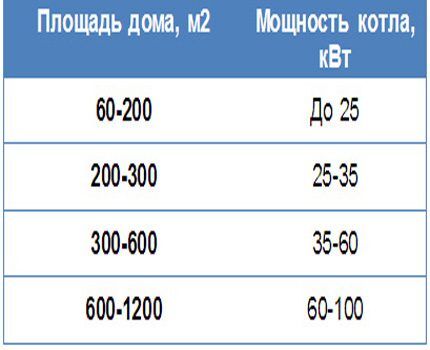
Secondly, we take into account the type of boiler and the principle of its operation:
- open or closed combustion chamber;
- convection or condensation;
- regular chimney or coaxial;
- one circuit or two circuits;
- the presence of automatic sensors.
In a closed chamber, fuel is burned more economically than in an open chamber. The efficiency of the condensing unit, thanks to the built-in additional heat exchanger for condensing the vapors present in the combustion product, increases to 98-100% compared to 90-92% efficiency of the convection unit.
WITH coaxial chimney the efficiency value also increases - cold air from the street is heated by the heated exhaust pipe. Due to the second circuit, of course, there is an increase in gas consumption, but in this case the gas boiler also serves not one, but two systems - heating and hot water supply.
Automatic sensors are a useful thing; they detect the external temperature and adjust the boiler to the optimal mode.
Thirdly, we look at the technical condition of the equipment and the quality of the gas itself. Scale and scale on the walls of the heat exchanger significantly reduce heat transfer; its deficiency must be compensated by increasing power.
Alas, gas can also contain water and other impurities, but instead of making claims to suppliers, we switch the power regulator a few notches towards the maximum level.
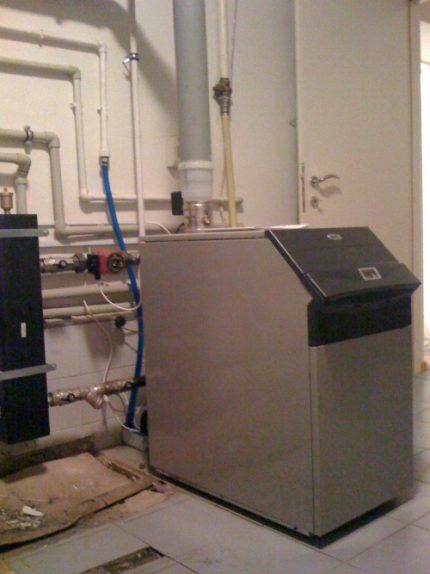
And, fourthly, the area of heated premises, natural heat loss, duration of the heating season, weather conditions. The more spacious the area, the higher the ceilings, the more floors, the more fuel will be required to heat such a room.
We take into account some heat leakage through windows, doors, walls, and roof. It doesn’t change from year to year, there are warm winters and bitter frosts - you can’t predict the weather, but the cubic meters of gas spent on heating directly depend on it.
Quick estimate
It is quite simple to estimate by eye how much gas will be consumed by your gas boiler.
We will start from either the volume of the heated room or its area:
- in the first case, we use the standard 30-40 W/cubic meter. m;
- in the second case - 100 W/sq. m.
The standards are taken taking into account the ceiling height in the room up to 3 meters. If you live in the southern regions, the numbers can be reduced by 20-25%, and for the north, on the contrary, they can be increased by one and a half times or doubled. Those. take in the second case, for example, 75-80 W/sq.m or 200 W/sq.m.
Multiplying the corresponding standard by volume or area, we get how many watts boiler power necessary for heating the room. Next, we proceed from the standard statement that modern gas equipment consumes 0.112 cubic meters of gas to generate 1 kW of thermal power.
We multiply again - this time the gas consumption standard (number 0.112) by the boiler power obtained in the previous multiplication (do not forget to convert watts to kW). We get the approximate gas consumption per hour.
The boiler usually works 15-16 hours a day. We calculate the daily gas consumption.Well, when the daily consumption is already known, we can easily determine the gas consumption for the month and for the entire heating season. The calculations are approximate, but quite sufficient to understand both the principle of calculation and the expected gas consumption.
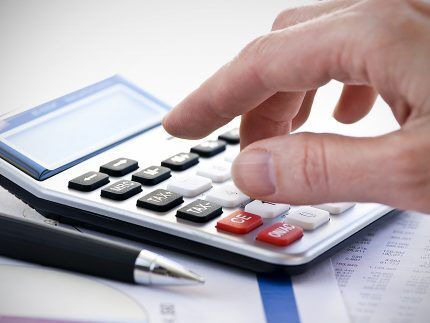
Example.
Let's say the area of the room is 100 m².
Let's calculate the boiler power: 100 W/sq. m * 100 m² = 10000 W (or 10 kW).
Let's calculate the gas consumption per hour: 0.112 cubic meters. m * 10 kW = 1.12 cubic meters. m/hour.
Let's calculate gas consumption per day (16 hours of operation), per month (30 days), for the entire heating season (7 months):
1.12 cu. m * 16 = 17.92 cubic meters m
17.92 cu. m * 30 = 537.6 cubic meters. m
537.6 cu.m. m * 7 = 3763.2 cubic meters. m
Note: you can immediately determine the monthly and seasonal power consumption of the boiler in kW/hour, and then convert it into gas consumption.
10 kW * 24/3*2 * 30 = 4800 kW/hour - per month
0.112 cubic meters * 4800 kW/hour = 537.6 cubic meters. m
4800 kW/hour * 7 = 33600 kW/hour - per season
0.112 cubic meters * 33600 kW/hour = 3763.2 cubic meters m
All that remains is to take the current gas tariff and convert the total into money. And if the project involves installing a double-circuit system that will not only heat the house, but also heat water for domestic needs, add to the power of the equipment and, accordingly, to the gas consumption floor-standing gas boilers heating another 25%.
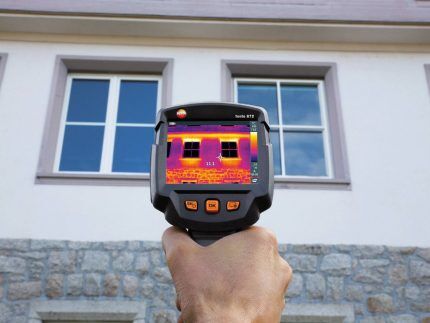
The boiler is connected to the main gas pipeline
Let us analyze the calculation algorithm that allows us to accurately determine the consumption of blue fuel for a unit installed in a house or apartment connected to centralized gas supply networks.
Calculation of gas consumption in formulas
For a more accurate calculation, the power of gas heating units is calculated using the formula:
Boiler power = QT * TO,
Where
QT — planned heat loss, kW;
K - correction factor (from 1.15 to 1.2).
The planned heat loss (in W) in turn is calculated as follows:
QT = S * ∆t * k / R,
Where
S—total area of enclosing surfaces, sq. m;
∆t—internal/outdoor temperature difference, °C;
k—dispersion coefficient;
R - value of thermal resistance of the material, m2•°C/W.
Dispersion coefficient value:
- wooden structure, metal structure (3.0 - 4.0);
- single brick masonry, old windows and roof (2.0 - 2.9);
- double brickwork, standard roof, doors, windows (1.1 - 1.9);
- walls, roof, floor with insulation, double glazed windows (0.6 - 1.0).
Formula for calculating the maximum hourly gas consumption based on the received power:
Gas volume = Qmax / (Qр * ŋ),
Where
Qmax — equipment power, kcal/hour;
QR — calorific value of natural gas (8000 kcal/m3);
ŋ — boiler efficiency.
In order to determine the consumption of gaseous fuel, you simply need to multiply the data, some of which must be taken from the technical data sheet of your boiler, some from construction reference books published on the Internet.
Using formulas by example
Let's assume that we have a building with a total area of 100 sq. m. The height of the building is 5 m, the width is 10 m, the length is 10 m, twelve windows measuring 1.5 x 1.4 m.Internal/external temperature: 20°C/-15°C.
We calculate the area of the enclosing surfaces:
- Floor 10 * 10 = 100 sq. m
- Roof: 10 * 10 = 100 sq. m
- Windows: 1.5 * 1.4 * 12 pcs. = 25.2 sq. m
- Walls: (10 + 10 + 10 + 10) * 5 = 200 sq. m
Minus windows: 200 – 25.2 = 174.8 sq. m
Thermal resistance value of materials (formula):
R = d/λ, where
d – material thickness, m
λ – coefficient of thermal conductivity of the material, W/[m•°С].
Calculate R:
- For the floor (concrete screed 8 cm + mineral wool 150 kg/m3 x 10 cm) R (floor) = 0.08 / 1.75 + 0.1 / 0.037 = 0.14 + 2.7 = 2.84 (m2•°C/W)
- For the roof (mineral wool sandwich panels 12 cm) R (roof) = 0.12 / 0.037 = 3.24 (m2•°C/W)
- For windows (double-glazed windows) R (windows) = 0.49 (m2•°C/W)
- For walls (mineral wool sandwich panels 12 cm) R (walls) = 0.12 / 0.037 = 3.24 (m2•°C/W)
The values of thermal conductivity coefficients for different materials were copied from a reference book.
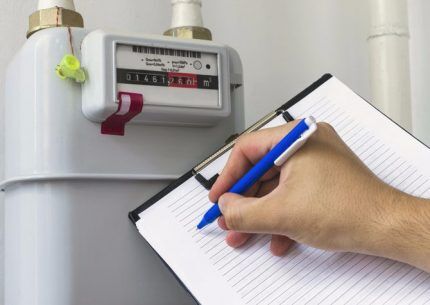
Now let's calculate the heat losses.
Q (floor) = 100 m2 * 20 °C * 1/ 2.84 (m2*K)/W = 704.2 W = 0.8 kW
Q (roof) = 100 m2 * 35 °С *1 / 3.24 (m2*K)/W = 1080.25 W = 8.0 kW
Q (windows) = 25.2 m2 * 35 °C * 1/ 0.49 (m2*K)/W = 1800 W = 6.3 kW
Q (walls) = 174.8 m2 * 35 °C * 1/ 3.24 (m2*K)/W = 1888.3 W = 5.5 kW
Heat loss from enclosing structures:
Q (total) = 704.2 + 1080.25 + 1800 + 1888.3 = 5472.75 W/h
You can also add heat loss through ventilation. To heat 1 m3 air from –15 °C to +20 °C requires 15.5 W of thermal energy.A person consumes approximately 9 liters of air per minute (0.54 cubic meters per hour).
Let's assume that there are 6 people in our house. They need 0.54 * 6 = 3.24 cu. m of air per hour. We calculate the heat loss for ventilation: 15.5 * 3.24 = 50.22 W.
And the total heat loss: 5472.75 W/h + 50.22 W = 5522.97 W = 5.53 kW.
After spending thermal calculation, we first calculate the boiler power, and then the gas consumption per hour in a gas boiler in cubic meters:
Boiler power = 5.53 * 1.2 = 6.64 kW (rounded to 7 kW).
To use the formula for calculating gas consumption, we convert the resulting power indicator from kilowatts to kilocalories: 7 kW = 6018.9 kcal. And let’s take the boiler efficiency = 92% (manufacturers of modern gas floor-standing boilers state this figure within 92 – 98%).
Maximum hourly gas flow = 6018.9 / (8000 * 0.92) = 0.82 m3/h.
The boiler is powered from a gas tank or cylinder
The formula Gas volume = Qmax / (Qр * ŋ) is suitable for determining the need for various fuels, incl. and liquefied gas. Let’s take from the previous example the resulting boiler power indicator - 7 kW. If such a boiler requires 0.82 m3/h of natural gas, how much propane-butane will be required then?
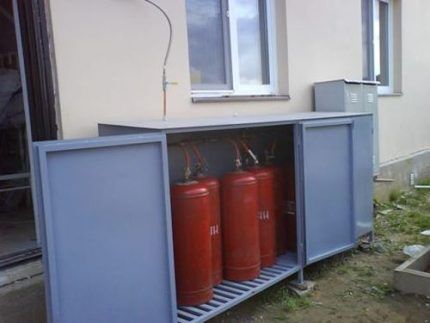
To calculate, you need to know what its calorific value is. Ud. the calorific value (this is the calorific value) of liquefied hydrocarbons in megajoules is 46.8 MJ/kg or 25.3 MJ/l.In kilowatt hours - 13.0 kW*h/kg and 7.0 kW*h/l, respectively.
Let's leave the efficiency of the gas heating boiler equal to 92% and calculate the hourly gas demand:
Gas volume = 7 / (13 * 0.92) = 0.59 kg/h
One liter of liquefied gas weighs 0.54 kg; in an hour the boiler will burn 0.59 / 0.54 = 1.1 liters of propane-butane. Now we calculate how much liquefied gas a gas boiler consumes per day and per month.
If the boiler operates for 16 hours, then per day - 17.6 liters, per month (30 days) - 528 liters. A typical 50-liter cylinder contains about 42 liters of gas. It turns out that for our house with an area of 100 m2 you will need 528 / 42 = 13 cylinders for a month.
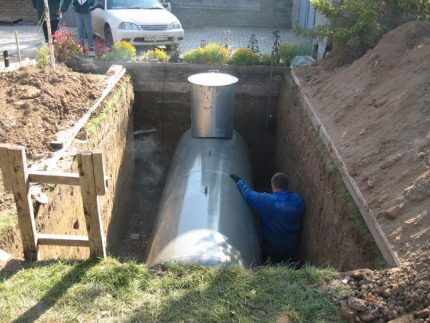
Installing a gas tank is much more convenient than replacing empty cylinders with full ones. It is enough to refill the gas tank 2-3 times during the entire heating season.
How to minimize gas consumption
To pay less money for the gas consumed by a floor-standing boiler and not widen your eyes in amazement at the sight of the next payment, follow these recommendations.
Firstly, pay attention to condensing boiler - the most economical for today. Its efficiency reaches 98-100% and higher. The price is high, but it will justify itself and will soon pay off. Read customer reviews for each model.
If you do not need water heating, take a single-circuit boiler. In a dual-circuit system, the gas demand includes an additional 20–25% that you don’t need.
Secondly, conscientiously insulate not only the walls, but also the roof, floor, foundation and basement. Install energy-saving double-glazed windows on your windows. Use a thermal imager.All cold spots must be found and eliminated. At the entrance to the house (corridor, hall, hallway) build a heated floor.
Third, use timers and sensors. The temperature you set for heating the air in the room will be adjusted automatically - for example, the batteries will heat up at night and cool slightly during the day.
If you decide to leave the house for a week, you can set the heating system to minimum during your absence and return to normal operation by the time you arrive. Once a year, a technical inspection is required to clear blockages and scale from the heat exchanger, traces of soot from the burner, and soot from the chimney.
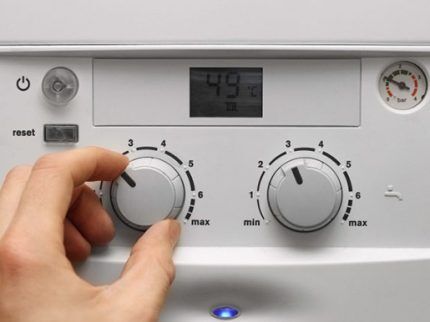
Fourthly, install a buffer storage tank in the heating system, which will contain a certain supply of coolant (hot water). Thanks to this “thermos”, which feeds the batteries for some time when the boiler is turned off, it is possible to save up to 20% of fuel.
Fifth, do not ignore proper ventilation. A window sash that is constantly ajar will transfer more heat to the street than a window that is wide open for five minutes.
Conclusions and useful video on the topic
The videos below talk about gas consumption for floor-standing boilers.
Heating using liquefied gas (propane). Fuel consumption, personal experience:
Gas consumption of a floor-standing gas boiler HOT SPOT 12 kW (user review):
Gas is a popular energy resource, and the problem of saving both the resource itself and the money to pay for it remains relevant.
Reasonable gas consumption means a good, economical boiler, professional installation of the heating system, and the fight against heat loss. The high efficiency of the unit is a guarantee of long-term savings on gas costs.
If you doubt the accuracy of your own calculations, ask for help from a qualified specialist who knows the smallest nuances of the formulas. His authoritative opinion will save you from mistakes both at the design stage of the heating system and during its operation.




I'm thinking about switching the house to gas heating. Many people write that this is much more profitable, but how “much” it is, with numbers, is almost nowhere to be found. Useful material.
Hello, Leonid. How do you heat your house now: solid fuel boiler, stove or electricity? I ask this question in order to understand what to compare with, to make calculations. It would be nice if you could also indicate the area of your home, this is also very important to provide you with accurate data.
Let's compare heating with gas and electricity. I’ll give you a ready-made example for an apartment of 36 m², and then you can make the necessary calculations yourself by plugging in your data.
There is an apartment of 36 m², in which electric convectors are installed in each room for heating. Energy consumption for the month solely for heating was 750 kW.
As for an apartment of similar size, it has a non-condensing single-circuit gas boiler with a coaxial chimney. The maximum power of the equipment is 7 kW. Such a boiler consumes 190 m3 of gas per month.
Now calculations, tariffs for the Moscow region:
1) Apartment with electric heating - 3.89 x 750 = 2917.5 rubles;
2) Apartment with gas heating - 5.7 x 190 = 1083 rubles.
As you can see, heating with gas is almost three times cheaper. I will also attach a table for the cost of materials, equipment and installation.